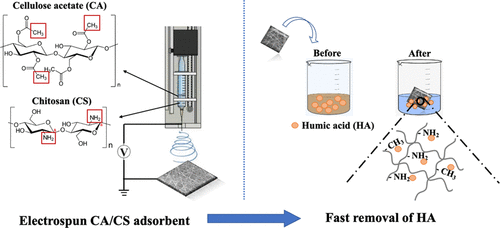当前位置:
X-MOL 学术
›
ACS Appl. Polym. Mater.
›
论文详情
Our official English website, www.x-mol.net, welcomes your feedback! (Note: you will need to create a separate account there.)
Electrospun Cellulose Acetate/Chitosan Fibers for Humic Acid Removal: Construction Guided by Intermolecular Interaction Study
ACS Applied Polymer Materials ( IF 5 ) Pub Date : 2021-09-14 , DOI: 10.1021/acsapm.1c00778 Yirong Zhang 1 , Fen Wang 1, 2 , Yixiang Wang 1
ACS Applied Polymer Materials ( IF 5 ) Pub Date : 2021-09-14 , DOI: 10.1021/acsapm.1c00778 Yirong Zhang 1 , Fen Wang 1, 2 , Yixiang Wang 1
Affiliation

|
Humic substance is a ubiquitous class of natural organic matter in soil and aquatic ecosystems, which severely affects the terrestrial and aquatic environments and water-based engineering systems. In our previous work, the adsorption of humic acid (HA) on self-assembled monolayers with different functional groups (OH-SAMs, CH3-SAMs, NH2-SAMs, and COOH-SAM) has been reported, where amino groups exhibited a superior adhesion energy toward HA followed by methyl groups and hydroxyl groups. Therefore, guided by the intermolecular interaction study, chitosan (CS) and cellulose acetate (CA) containing -NH2 and -CH3 groups derived from waste materials were selected to fabricate electrospun fibrous adsorbents for the removal of HA from aqueous solutions in this work. The effect of CA/CS ratios on the structure and adsorption performance of electrospun fibers was investigated in detail. The results revealed that all the samples (CA/CS = 3:1, 1:1, 1:3) showed high adsorption capacities (>152 mg/g) toward HA at pH 4. This was because of the abundant functional groups on the surface of fibers. Especially, the CA/CS 1:1 sample had a uniform fibrous morphology with an average diameter of 335 ± 242 nm, which led to the highest tensile strength of 2.97 ± 0.59 MPa and adsorption capacity of 184.72 mg/g. The adsorption of HA onto CA/CS fibers was nonspontaneous and exothermic in nature. It followed the pseudo-first-order kinetic model and was primarily driven by electrostatic interaction. The adsorption isotherm was better fitted by the Langmuir model. Therefore, this work demonstrates the feasibility to use intermolecular interaction mechanisms to guide the design of functional materials. Moreover, it provides a biodegradable efficient adsorbent that is promising for the applications in water treatment.
中文翻译:

用于去除腐植酸的静电纺醋酸纤维素/壳聚糖纤维:分子间相互作用研究指导的构建
腐殖质是土壤和水生生态系统中普遍存在的一类天然有机物质,严重影响陆生环境和水基工程系统。在我们之前的工作中,已经报道了腐殖酸 (HA) 在具有不同官能团(OH-SAM、CH 3 -SAM、NH 2 -SAM 和 COOH-SAM)的自组装单层上的吸附,其中氨基表现出对 HA 的优异粘附能,其次是甲基和羟基。因此,在分子间相互作用研究的指导下,含有-NH 2和-CH 3 的壳聚糖(CS)和醋酸纤维素(CA)在这项工作中,选择来自废料的基团来制造用于从水溶液中去除 HA 的电纺纤维吸附剂。详细研究了CA/CS比对电纺纤维结构和吸附性能的影响。结果表明,所有样品(CA/CS = 3:1、1:1、1:3)在 pH 4 时对 HA 表现出高吸附容量(>152 mg/g)。这是因为在纤维表面。特别是,CA/CS 1:1 样品具有均匀的纤维形态,平均直径为 335±242 nm,最高拉伸强度为 2.97±0.59 MPa,吸附容量为 184.72 mg/g。HA 在 CA/CS 纤维上的吸附本质上是非自发的和放热的。它遵循准一级动力学模型,主要由静电相互作用驱动。Langmuir 模型更好地拟合了吸附等温线。因此,这项工作证明了使用分子间相互作用机制指导功能材料设计的可行性。此外,它提供了一种可生物降解的高效吸附剂,有望用于水处理。
更新日期:2021-10-08
中文翻译:

用于去除腐植酸的静电纺醋酸纤维素/壳聚糖纤维:分子间相互作用研究指导的构建
腐殖质是土壤和水生生态系统中普遍存在的一类天然有机物质,严重影响陆生环境和水基工程系统。在我们之前的工作中,已经报道了腐殖酸 (HA) 在具有不同官能团(OH-SAM、CH 3 -SAM、NH 2 -SAM 和 COOH-SAM)的自组装单层上的吸附,其中氨基表现出对 HA 的优异粘附能,其次是甲基和羟基。因此,在分子间相互作用研究的指导下,含有-NH 2和-CH 3 的壳聚糖(CS)和醋酸纤维素(CA)在这项工作中,选择来自废料的基团来制造用于从水溶液中去除 HA 的电纺纤维吸附剂。详细研究了CA/CS比对电纺纤维结构和吸附性能的影响。结果表明,所有样品(CA/CS = 3:1、1:1、1:3)在 pH 4 时对 HA 表现出高吸附容量(>152 mg/g)。这是因为在纤维表面。特别是,CA/CS 1:1 样品具有均匀的纤维形态,平均直径为 335±242 nm,最高拉伸强度为 2.97±0.59 MPa,吸附容量为 184.72 mg/g。HA 在 CA/CS 纤维上的吸附本质上是非自发的和放热的。它遵循准一级动力学模型,主要由静电相互作用驱动。Langmuir 模型更好地拟合了吸附等温线。因此,这项工作证明了使用分子间相互作用机制指导功能材料设计的可行性。此外,它提供了一种可生物降解的高效吸附剂,有望用于水处理。



























 京公网安备 11010802027423号
京公网安备 11010802027423号